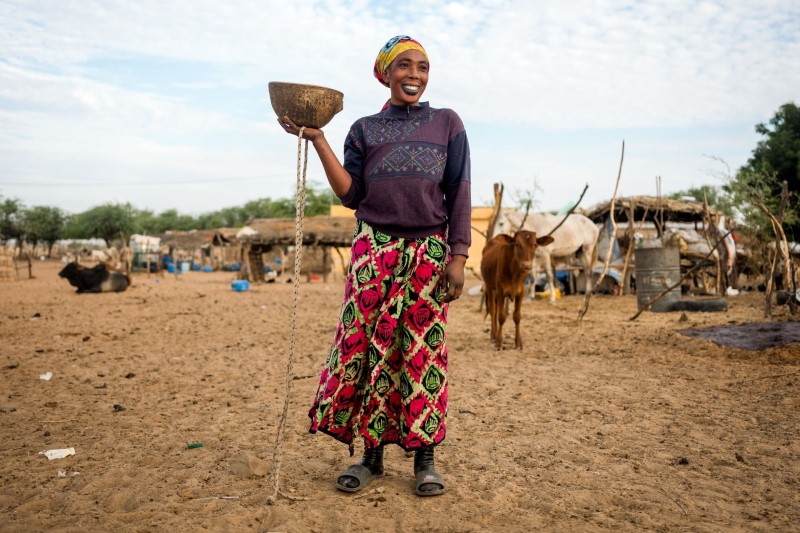
Dairy products are an important source of nutrition in Senegal, but preventing foodborne illness in local supply chains is challenging to maintain across the system of small farms, aggregation sites, and artisanal processing facilities. Two papers published by researchers working with the Feed the Future Innovation Lab for Food Safety (FSIL) highlight the challenges and potential solutions to increasing the food safety of milk production and processing in Senegal.
“The burgeoning local dairy industry in rural areas of the country has significant potential to promote economic development, improving the economic prospects for women and youth in particular, as they play critical roles in the dairy value chain,” said Manpreet Singh, FSIL’s Senegal project leader and head of the Department of Food Science and Technology at the University of Georgia. “Achieving self-sufficiency, rather than relying on imported milk and milk powder, is a top priority for Senegal’s government. But we needed a baseline understanding of food safety gaps in production and processing gained through these review papers to develop data-driven safety practices, policy recommendations, and training for food-safety professionals.”
The first paper, Food Safety Issues in Dairy Production in Senegal: Challenges and Pragmatic Solutions for the Dairy Value Chain, was published in the January/February issue of Food Protection Trends and addresses concerns in small-scale dairy production. Among the foremost challenges is preventing contamination with bacterial foodborne pathogens. The authors note that milk is typically consumed unpasteurized in raw or fermented form, increasing the risk from Mycobacterium bovis, Brucella abortus, and Coxiella burnettii, all of which pose significant public health concerns. Data is scarce on the incidence of Salmonella, E. coli, and Listeria, which are common pathogens in dairy production systems around the world.
Raising awareness about food safety risks and addressing traditional beliefs about milk are key to reducing foodborne illness, according to lead author Woubit Abebe, DVM, director of the Center for Food Animal Health, Food Safety, and Food Defense in the Department of Pathobiology at Tuskegee University.
“A large number of people, men more than women, don’t believe that unpasteurized milk could transmit illness,” Abebe said. “They don’t boil the milk at all. Boiling for them is like taking the soul out of the milk.”
Abebe’s current research and outreach efforts with project collaborators at Senegal’s Institut de Technologie Alimentaire (ITA) address the challenges identified in the review. Abebe and her team have conducted detailed surveys to understand current milk production practices on small dairy farms.
“Do they practice cleaning the udder? Do they wash their hands before milking? What kind of towel are they using to dry their hands?” Abebe said. “Even little things may make a difference.”
This spring, Abebe is training students and staff at ITA in pathogen sampling methods to characterize the risk from more than a dozen common pathogens of dairy systems in preparation for on-farm sample collection. This data will fill gaps in current knowledge and help the team identify the most important targets for new food safety practices.
The team’s other paper, Safety and Quality of Milk and Milk Products in Senegal—A review, was published in the November 2022 issue of MDPI Foods and provides a complementary analysis of food safety challenges after milk leaves the farm–during transit, processing, and sale.
The authors conclude that the main food safety challenges arise from the informal milk collection systems for delivery of raw milk to processors; traditional, artisanal processing methods that don’t include heat treatment; and the lack of consistent refrigeration to slow microbial growth. Together, they significantly increase the risk of foodborne illness from bacterial pathogens. The solutions lie in outreach, infrastructure, and science-based food safety interventions.
“There is a need to educate milk producers, small-scale processors, and vendors on common food safety measures for milk and milk products, particularly the importance of refrigerating milk immediately after milking as well as maintaining the cold chain until the milk is heat treated and subsequently marketed to the consumer,” said Singh. “Proper operation of equipment such as pasteurizers to ensure the safety of milk is a key focus, along with a comprehensive risk assessment of high-risk areas for cross-contamination that can compromise the safety of the dairy value chain.”
Singh believes it is important to establish large, organized dairies to collect milk from rural production areas as well as to develop small-scale processing units such as mini dairies, noting that economics can constrain food safety efforts. Without assistance, obtaining the equipment necessary for cold storage and processing of milk can be challenging for farmers and small-scale dairies. He also stressed the importance of engaging women and youth.
“Youth and women play key roles in the dairy value chain, therefore, involvement of these groups on decision-making as it relates to policies and ensuring safety of the dairy value chain is critical,” he said.
In addition to Abebe and Singh, the Food Protection Trends article on dairy production was coauthored by Rawah Faraj (Tuskegee University), Cheikh Ndiaye (ITA), Younoussa Diallo (ITA), and Harshavardhan Thippareddi (UGA). Coauthors of the MDPI Foods article on dairy processing include lead author Cortney Leone (UGA), Harshavardhan Thippareddi (UGA), Cheikh Ndiaye (ITA), Ibrahima Niang (ITA), and Younoussa Diallo (ITA).
Christina Frank is a freelance writer with the Feed the Future Innovation Lab for Food Safety.

